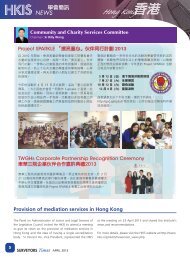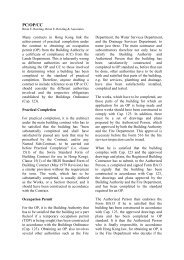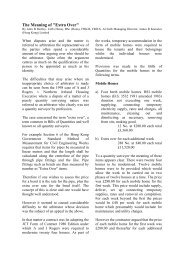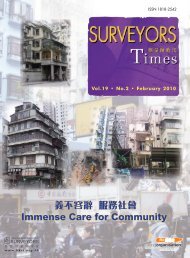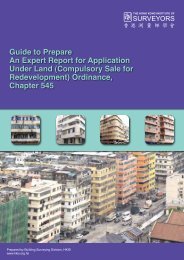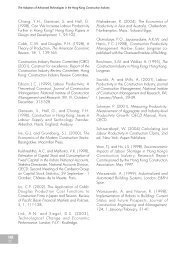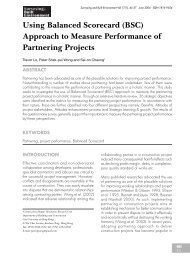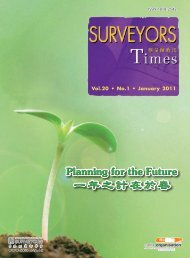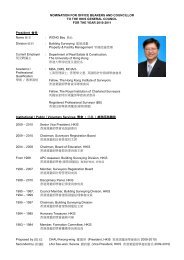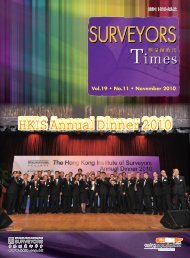Surveying & Built Environment Vol. 22 Issue 1 (December 2012)
Surveying & Built Environment Vol. 22 Issue 1 (December 2012)
Surveying & Built Environment Vol. 22 Issue 1 (December 2012)
Create successful ePaper yourself
Turn your PDF publications into a flip-book with our unique Google optimized e-Paper software.
SBE<br />
50<br />
Good Property Valuation in Emerging Real Estate Markets? Evidence from Ghana<br />
PV is Property Value<br />
The procedure looks neat and simple<br />
but, in practice , it is a labyrinthine<br />
process, involving several twists and<br />
turns.<br />
Assessing GRC and Depreciation<br />
First they estimate the gross<br />
replacement cost (GRC), which is the<br />
cost of producing a substitute property<br />
as new or functionally similar to the<br />
subject property (See Scarrett, 2008,<br />
pp.162-163 for other ways of estimating<br />
cost). Rating information about<br />
buildings may be helpful in this sense.<br />
However, in Ghana, that information<br />
is dated because local authorities – for<br />
want of adequate resources – do not<br />
produce valuation lists on a regular<br />
basis (see Mensah, 2005). So, in<br />
practice, such costs would typically<br />
be obtained from bills of quantities<br />
(BOQs), which are prepared by quantity<br />
surveyors who consider current labour<br />
and building materials costs and the<br />
cost of building techniques. More<br />
diligent valuers usually take their cost<br />
figures from BOQs that have undergone<br />
tendering because such BOQs are<br />
deemed to be slightly reflective of the<br />
‘real’ market value.<br />
Second, they estimate accrued<br />
depreciation to reflect physical defects,<br />
functional and economic obsolescence<br />
(for a discussion, see Albritton, 1982;<br />
Mansfield and Pinder, 2008; Hackman<br />
and Scott, 2008). Surveyors often<br />
grapple with how to estimate one figure<br />
for all the aspects of depreciation.<br />
Gyamfi-Yeboah and Ayittey (2006,<br />
pp. 8-9) propose a ‘decomposition<br />
approach’ to the problem by estimating<br />
the individual contribution of each<br />
component of depreciation in the<br />
first instance to provide a basis for<br />
estimating a combined depreciation<br />
rate, which takes into account the<br />
weight of each component. However,<br />
in practice, such ‘academic’ approaches<br />
are hardly used. The valuers use their<br />
‘experience’; a colloquial way of saying<br />
that they judge how much is required<br />
to restore the property to its new state.<br />
A more structured way of estimating<br />
depreciation is to make reference to the<br />
operational percentage chart – a figure<br />
which shows how much each part of a<br />
building contributes to the total cost –<br />
and estimate how much depreciation<br />
should be ascribed to the various parts<br />
of the subject building. This estimate of<br />
depreciation is deducted from GRC to<br />
arrive at net replacement cost (NRC).<br />
Estimating Land Value and PV<br />
In theory at this stage in using the<br />
Cost Approach, land value should<br />
be estimated typically by the Market<br />
Comparison approach. That is,<br />
comparable land values would need to be<br />
found for the subject property, assuming<br />
it is vacant and put to its highest<br />
and best use. The comparables must<br />
come from the same neighbourhood<br />
or class of neighbourhood, if there<br />
is limited information in the subject<br />
neighbourhood. Valuers usually obtain<br />
this information particularly from<br />
three sources, namely reference to land<br />
registries, reference to judicial cases<br />
about compensation, and reference<br />
to past valuations by fellow valuers.<br />
However, as we have seen, the land<br />
registries, judicial guidance and<br />
information from cases of compensation<br />
provide limited information.<br />
So, in practice, Aryittey et al. (2006)<br />
report that valuers in Ghana usually<br />
consult one another for information



